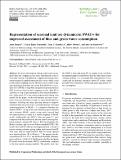| dc.description.abstract | In most (sub)-tropical African cultivated regions, more than one cropping season exists following the (one or two) rainy seasons. An additional cropping season is possible when irrigation is applied during the dry season, which could result in three cropping seasons. However, most studies using agro-hydrological models such as the Soil and Water Assessment Tool (SWAT) to map blue and green evapotranspiration (ET) do not account for these cropping seasons. Blue ET is a portion of crop evapotranspiration after irrigation application, while green ET is the evapotranspiration resulting from rainfall. In this paper, we derived dynamic and static trajectories from seasonal land use maps to represent the land use dynamics following the major growing seasons to improve simulated blue and green water consumption from simulated evapotranspiration in SWAT+. A comparison between the default SWAT+ set-up (with static land use representation) and a dynamic SWAT+ model set-up (with seasonal land use representation) is made by a spatial mapping of the ET results. Additionally, the SWAT+ blue and green ET were compared with the results from the four remote sensing data-based methods, namely SN (Senay), EK (van Eekelen), the Budyko method, and soil water balance method (SWB). The results show that ET with seasonal representation is closer to remote sensing estimates, giving higher performance than ET with static land use representation. The root mean squared error decreased from 181 to 69 mm yr−1, the percent bias decreased from 20 % to 13 %, and the Nash–Sutcliffe efficiency increased from −0.46 to 0.4. Furthermore, the blue and green ET results from the dynamic SWAT+ model were compared to the four remote sensing methods. The results show that the SWAT+ blue and green ET are similar to the van Eekelen method and performed better than the other three remote sensing methods. It is concluded that representation of seasonal land use dynamics produces better ET results, which provide better estimations of blue and green agricultural water consumption. | en_US |

